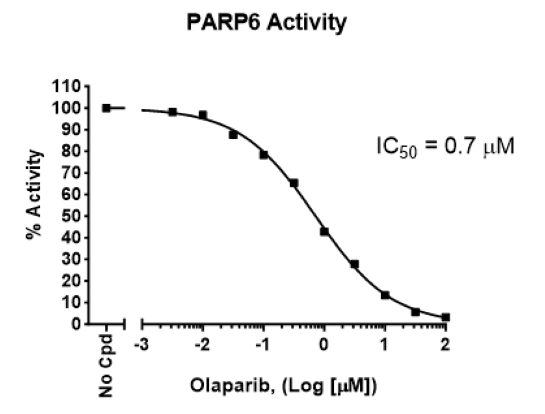PARP6 Chemiluminescent Assay Kit
The PARP6 Chemiluminescent Assay Kit is designed to measure the activity of PARP6 (poly-(ADP-ribose) polymerase 6) for screening and profiling applications. The PARP6 assay kit comes in a convenient 96-well format, with enough recombinant purified PARP6 enzyme, reaction substrates, and PARP assay buffer for 100 enzyme reactions.

Figure 1. PARP6 Chemiluminescent Assay Kit schematic.
Histone proteins are coated on a 96-well plate. Next, a biotinylated NAD+ mix (termed PARP Substrate Mixture) is incubated with the PARP6 enzyme in an optimized assay buffer. The plate is then treated with streptavidin-HRP followed by addition of the ELISA ECL substrate to produce chemiluminescence that can be measured using a chemiluminescence reader. The chemiluminescence signal is proportional to the PARP6 activity.
Need us to run inhibitor screens or profile your compounds against PARP6? Check out our PARP/PARPTrap™ Screening Services or DNA Replication and Repair Screening Services.
This product has been cited 2 times.
- 1x PBS (Phosphate Buffer Saline) Buffer
- PBST Buffer (1x PBS, containing 0.05% Tween-20)
- Luminometer or microplate reader capable of reading chemiluminescence
- Adjustable micropipettor and sterile tips
- Rotating or rocker platform
| Catalog # | Name | Amount | Storage |
| 80506 | PARP6, GST-Tag* | 25 µg | -80°C |
| 52029 | 5x Histone Mixture | 1 ml | -80°C |
| 78371 | PARP Substrate Mixture 2 | 4 x 250 µl | -80°C |
| 80602 | 10x PARP Assay Buffer | 1 ml | -20°C |
| 79743 | Blocking Buffer 3 | 25 ml | +4°C |
| 0.5 M DTT | 200 µl | -20°C | |
| 80611 | Streptavidin-HRP | 100 µl | +4°C |
| 79670 | ELISA ECL Substrate A (translucent bottle) | 6 ml | Room Temp |
| ELISA ECL Substrate B (brown bottle) | 6 ml | Room Temp | |
| 79837 | 96-well module plate | Room Temp |
*The concentration of the protein is lot-specific and will be indicated on the tube.
PARP6, also known as poly-(ADP-ribose) polymerase 6 or NAD+ ADP-ribosyltransferase 6, is part of the PARP family. ADP ribosylation, which is the addition of an ADP-ribose to a protein, is a reversible post-translational modification of proteins mostly involved in the DNA Damage Response (DDR) pathway. Mono-ADP-ribosylation (termed MARylation) is the addition of a unit of ADP-ribose. PARP6 is involved in brain development, controlling dendrite morphogenesis, and it may be involved in disorders such as autism and Rett’s syndrome. In the absence of PARP6, DNA repair is less efficient, and cytotoxicity is potentiated when DNA damaging insults occur. PARP6 correlates with poor prognosis in breast, pancreatic and other cancer types. PARP6 can monoribosylate Chk1 (checkpoint kinase 1) and inactivate mitotic proteins, indicating a role of PARP6 in mitosis. It was also proposed that PARP6 can inhibit hepatocellular carcinoma by acting on the XRCC6 (X-ray repair cross complementing 6)/Wnt/β-catenin pathway. Use of AZ0108, a PARP inhibitor, resulted in MPS (multipolar spindle) and apoptosis in vitro and in vivo. A deeper understanding of PARP6 functions is required, and the development of molecules targeting PARP6 is a promising new cancer therapy tool.
Huang J., et al., 2016 Scientific Reports 6: 18512.
Wang Z., et al., 2018 Cancer Res 78(23): 6691-6702.
Tang B., et al., 2020 Am J Cancer Res 10(7):2100-2113.


